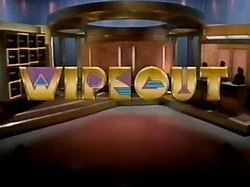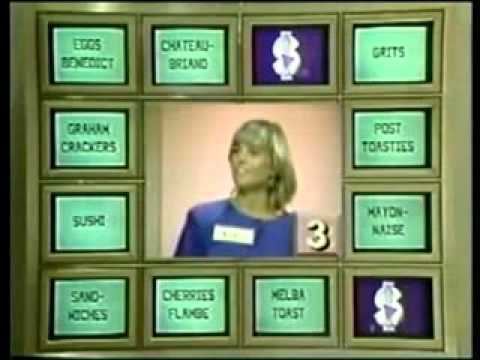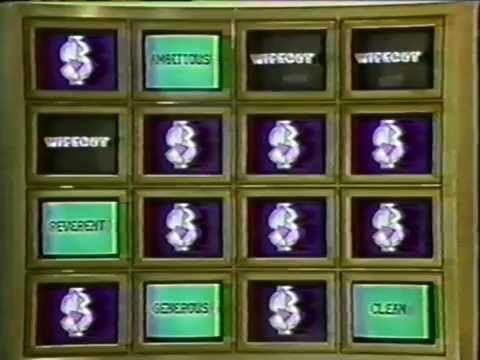6 /10 1 Votes
Genre Game show Directed by Jerome Shaw Country of origin United States Final episode date 9 June 1989 Number of episodes 195 Program creator Bob Fraser | 6/10 IMDb Created by Bob Fraser Theme music composer Otis Conner First episode date 12 September 1988 Presented by Peter Tomarken Original network Syndicated | |||||||||||||||||||||||||||||||||
 | ||||||||||||||||||||||||||||||||||
Narrated by Jim Hackett
Robert Ridgely
John Harlan Similar Game show, Hit Man, Whammy! The All‑New P, Press Your Luck, Marblehead Manor | ||||||||||||||||||||||||||||||||||
Wipeout 1988 v3
Wipeout is an American game show that aired from September 12, 1988 to June 9, 1989, with Peter Tomarken as host. The series was produced by Dames-Fraser Productions and distributed by Paramount Domestic Television.
Contents
- Wipeout 1988 v3
- Wipeout 1988 v1
- First round
- Hot Spot
- Challenge Round
- Bonus round
- Germany
- Greece
- Netherlands
- Spain
- Format changes
- References

Reruns of the series later aired on the USA Network from 1989 to 1991.
Wipeout 1988 v1
First round

Three contestants competed on each episode. Initially, each game featured three new contestants. After several weeks, the show instituted a returning champion policy.

The players were given a category and shown 16 possible answers on a 4-by-4 grid of monitors. Eleven answers were correct, while the five incorrect ones were referred to as "Wipeouts" (In one episode, Tomarken accidentally referred to them as "Whammies" from Press Your Luck, Tomarken's well known game show), The contestant in the leftmost position began the round.
The contestant in control chose one answer at a time; each correct answer awarded money, while finding a Wipeout reset the score to zero and ended his/her turn. After each correct answer, he/she could either choose again or pass control to the next contestant. The first correct answer of the round was worth $25, and the value of each subsequent answer increased by $25, with the last one worth $275.
The round ended once all eleven correct answers were found or if all five Wipeouts had been selected. The two contestants with the highest money totals continued on, while the third place player left with parting gifts and, if he/she had been the champion, any prior winnings.
If there was a tie for low score, the tied players were given a new category and shown 12 answers (eight right, four Wipeouts). They alternated choosing one answer at a time, with a coin toss to decide who would start, and the first contestant to find a Wipeout was eliminated. If all eight correct answers were found, the contestant who gave the last one advanced.
"Hot Spot"
One of the eleven correct answers was referred to as the "Hot Spot", with a prize attached to it. Once the Hot Spot was uncovered, Tomarken would take a token from inside his podium and place it on the desk of the contestant that found it.
In order to win the Hot Spot prize, a contestant had to both be in possession of the token at the end of the round and have a high enough score to advance to the Challenge Round. If the contestant holding the Hot Spot uncovered a Wipeout, the token was taken away and another answer was designated as the Hot Spot.
Challenge Round
The two remaining contestants advanced to the Challenge Round, playing for a bonus prize and to become the day's champion.
For each category in the Challenge around, the contestants were shown a board with 12 answers, eight correct and four Wipeouts, and they bid back and forth as to how many correct answers they thought they could name. Bidding ended when one contestant either reached the maximum of eight or challenged the other. If the high bidder successfully completed the bid, he/she won the board. One mistake allowed the opponent a chance to steal the board by giving one of the remaining correct answers still on the board. If the opponent could not do so, the high bidder was given another chance to fulfill his/her bid.
The Challenge Round was played as a best two-of-three. The high scorer from the first round started the bidding on the first board, while his/her opponent led off for the second. If a third board was needed, a coin toss decided who would start the bidding.
The first contestant to win two boards became champion. The opponent got to keep whatever money and prizes he/she had won in the first part of the game.
Bonus round
Instead of using the 4-by-4 monitor grid from the main game, the bonus round used a grid of 12 larger monitors, arranged in three rows of four. The champion attempted to win a new car by identifying six correct answers in a given category within sixty seconds.
After receiving the category, the champion raced to the monitors to select his/her answers. To do this, the champion would have to touch the border around one of the monitors. The monitor would then light up to indicate the selection. Once six monitors were selected, the champion then raced back to the starting point and hit a button to lock the answers in.
If there were less than six correct, Tomarken would tell the champion how many he/she had correctly chosen and he/she went back to the grid. In order to change an answer, the champion had to touch the monitor again to turn it off before selecting a new one because no more than six could be lit at once. The process continued until all six correct answers were found or until the sixty second time limit expired.
If the champion managed to find all six answers within the time limit, he/she won the car. This also resulted in the champion retiring undefeated once carryover champions were introduced. Otherwise, the champion would keep returning until beaten.
Germany
The German version is called Riskier Was! (lit. Risk Something!) aired on Sat.1 hosted by Gundis Zámbó aired on Sat.1 from 1994 to 1995. Unlike other international versions of Wipeout, this version alone had a blue cartoon Rhino as the mascot of the show.
Greece
The Greek version is called Risko aired on Mega Channel from 1995 until 1997, hosted by Giorgos Polixroniou.
Netherlands
The Dutch version is called Denktank (lit. Think Tank) aired on RTL 4, RTL 5 & Veronica from 1994 until 1999, hosted by Kas Val Lersen.
Spain
A Spanish version originally called "Alta Tensión" (lit. "High Voltage"), and later "Tensióm sin Límite" (lit. "Unlimited Voltage") had three separate runs: one from 1998 to 1999 on Antena 3 hosted by Constantino Romero, one from 2006 to 2008 on Cuatro with Luis Larrodera as host, and one in 2011 on Veo7 with Ivonne Reyes as host.
Format changes
Round 1 was played with three boards like the UK. For the first two boards, €100 was awarded for the first answer plus an additional €100 for every subsequent correct answer revealed, up to €1,000 for the tenth correct answer (only ten correct answers are on the board). The third board paid €200 for the first answer plus an additional €200 for every subsequent correct answer revealed (up to €2,000 for the tenth correct answer); instead of a bonus prize, one of the answers on one of the boards hid a "wild card," which preserved the money if a player found a Wipeout.
In round 2, instead of bidding, one player selects a category, after which their opponent selects answers until finding a Wipeout, at which point their opponent takes over control of the board. A player wins the board by selecting the eighth and final correct answer. If one player finds the fourth wrong answer, their opponent automatically wins the board.
In the bonus round, seven of the answers were right, and five were wrong. Trying to turn on more than seven answers resulted in an error tone and the answer not being activated. Like in America, winning the bonus round awarded a new car.
